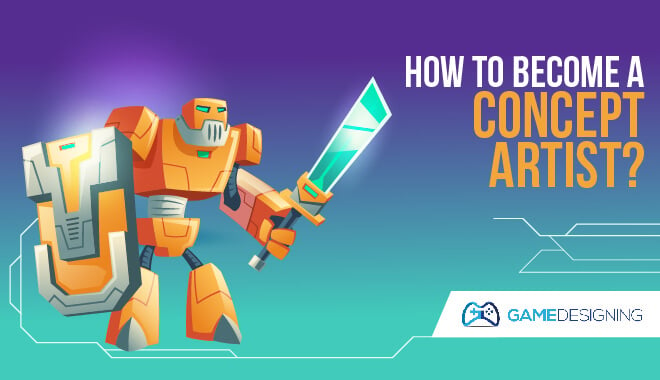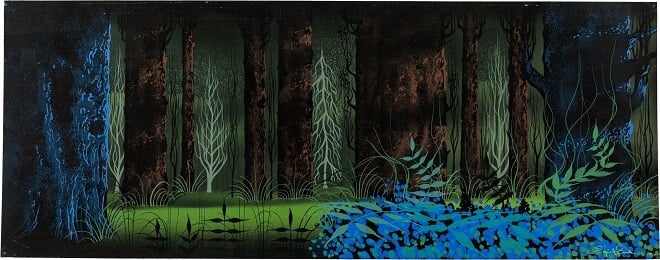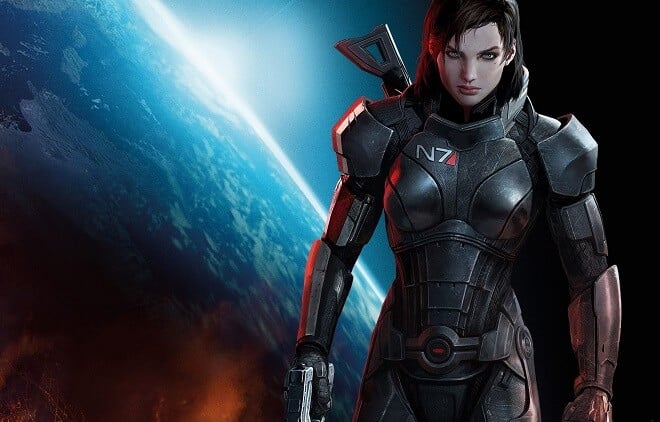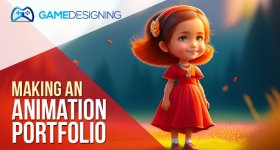
If you’ve ever been blown away by the creatures, scenery, or items in a movie or video game, then you’ve seen the end result of a concept artist’s work without even knowing it.
A concept artist is a designer who takes the design team’s ideas and turns them into an artwork guide for making the sets, 3D models, or VFX.
In this article, you’ll learn everything you need to know about this fascinating career, as well as the steps to becoming a concept artist yourself.
What Is Concept Art?
Concept art is any piece of art that is used as a reference to create assets for a game or movie. Pictures can convey a lot more than words when it comes to explaining what you want something to look like. So concept art is used to give the design team a muse, or visual representation of what they’re going to create.
Concept artists have some freedom to put a lot of their personality and creativity into their work but have to make sure the concept art is tonally consistent with the rest of the design team’s vision.
If a film is set in a bleak dystopian world, the concept art should show the set designers, VFX artists, and the lighting department how that should look when their job is done.
If a game has a colorful, cartoonish art direction, then the concept art for every item, character, building, article of clothing, and vehicle should reflect this tone.
In other words, good concept art not only helps make a film or movie more vibrant and creative but makes sure everyone is on the same page during production.
Concept art is the foundation upon which the world of a game is built.
The Different Types of Concept Art
Concept artists may specialize in different types of concept art. While one artist may be great at designing architecture and buildings, another might specialize in drawing characters or items.
In fact, having a unique style and signature techniques are what set the most famous concept artists apart.
Eyvinde Earl for example is a legendary concept artist who worked on several Disney classics such as Peter Pan and Sleeping Beauty. His concept art featured highly stylized tree and plant life and became a staple of the design of those early films.

Jason Chan, on the other hand, a prolific concept artist in the games industry, is most known for his character designs, which have contributed to works such as League of Legends and Mass Effect.
In fact, most of the character models in Mass Effect 3 were created as concept art by Jason Chan.

In other words, depending on the needs of the project, different artists can flourish. Creature design, character design, tech design, asset design, and environment design are all different categories that require a concept artist.
An extremely talented artist can build their entire portfolio based around just one of these categories if their work is notable enough, although most concept artists have to be able to handle a variety of these categories to make sure their work is steady, even if they have a particular specialty.
Either way, the personal style of an artist’s work will play a big role in the sort of projects they can get hired for, and it’s ok for them to do better in some areas than in others.
Concept art for Halo Infinite will look vastly different from concept art from Genshin Impact after all.
Why Become A Concept Artist?
For many artists, the dream of seeing their work used in a film or video game is very enticing. It’s more than just a career, but a chance to contribute creatively to an industry you love.
A concept artist can point at vivid landscapes, sci-fi machines, inhuman monsters, and powerful weapons and say “I created that.”
What they draw is the foundation the rest of the team uses to make the film or game, and so while they do have limitations, the impact that concept artists can have on a project is tremendous.
On top of that, concept artists make an average salary of $69,000 a year, with the most veteran artists making up to $90,000.
What Does A Concept Artist Do?
When making a video game, for example, the team might have cool ideas for the magic axe that the main character will wield throughout the game.
But no matter how much they talk about it, everyone will have a slightly different idea of what that axe will look like in their head.
That’s where the concept artist comes in.
They’ll listen to everyone’s ideas, be given a written brief by the art director with detailed instructions on what the team wants, and use it to sketch some basic designs for the axe so everyone can see if they’re on the same page.
Even then, most concept artists will build up a visual library of art, materials, textures, and photographs to help them create their work. That’s right–concept artists use visual references to create visual references.
This means that after getting a feel for the tone of the project, they may have to do some research to find the best reference images to suit their needs.
After seeing the basic outlines the concept artist presents, the team may change their mind about exactly what they want. Maybe the team decides the skull on the axe’s handle doesn’t look as impressive as they thought it would, or they have a better idea for its shape.
The concept artist will create detailed artwork of the axe using either 2D or 3D art software such as ZBrush or Photoshop, but can often expect to make revisions until the final design is agreed upon.
Once it’s all finished, the other teams will take the concept art and use it to create textures and 3D models to render it into the game.
Depending on the scale of the project, both films and movies could either have a single concept artist or a handful working on different things.
How to Become a Concept Artist
So now that we’ve covered what a concept artist is, and why it’s definitely a career worth pursuing, what does it take to actually become a concept artist? Here are five steps to landing yourself a career in this competitive art field.
Education
Technically speaking, you don’t need a formal education to become a concept artist. The artwork you are able to produce and add to your portfolio is more important for getting hired as a concept artist than a college or university degree. And experience is the most valuable asset an artist can have. With that said, most concept artists do enter the field after obtaining a degree.
Unless you’re a prodigy, it’s difficult to become an artist at a professional level without first having an understanding of the fundamentals; form, composition, perspective, anatomy, lighting, and color.
Having a familiarity with Zbrush, Maya, and Photoshop is also a must, as this software is widely used across the industry.
So while getting a degree isn’t mandatory, attending an art school could be a crucial step to learning the skills you need to succeed as a concept artist. Your best bet is to go for a degree in graphic design or fine arts, as these courses will typically help you build up a compelling art portfolio by the end of the course.
But if you want a cheaper way to learn the ins and outs of concept art and design, you’re in luck! There are a number of free tutorials and lessons in drawing concept art made by professionals in the industry. These can be found on websites such as Artstation.com and clipstudio.net.
These tutorials are made by artists, for artists, and give you a step-by-step guide to anything you need to know when it comes to creating concept art. The lessons can be on broad subjects, such as color theory, composition, and lighting.
But there are also more specific lessons on offer here; like how to design realistic metal engravings, cityscapes, or silhouettes. The tutorials may not be the equivalent of four years of art school, but they can give you a firm foundation in the world of concept art.
Creating A Concept Art Portfolio
For a professional artist in any industry, having a compelling portfolio of your work is much more important than even a well-written resume. When it comes to getting a job in the arts, concept artists are certainly no exception to this. An artist’s portfolio is a collection of their best work, showcasing the artist’s abilities and skills in a visual way.
The only problem is, a concept artist may have created art in a number of different styles. So how do you choose what to add to your portfolio and what to leave out if you’re designing everything from vehicles to characters?
Even expert artists are known to update their portfolios every now and then, as their work grows more advanced and their tastes change. So if your portfolio isn’t looking up to par just yet, then consider doing some concept art commissions and small one-off art jobs.
It’s a lot different than working in a studio for a big film or game company, but you may be able to buff up your portfolio with impressive, professional art and make some money doing it until your portfolio is ready.
Picking Your Best Work
This may go without saying, but many art graduates make the mistake of filling their portfolio with work that isn’t up to par with where their skills truly are.
It’s very tempting to want to fill up the empty space of your portfolio with whatever you happen to have, but if only two out of ten concept art pieces on display are of a professional quality, then what the employer sees is an artist whose work will miss the mark eight out of ten times.
While quantity can be important, as it can show the artist has a number of projects under the belt, it can’t be emphasized enough that quality is what’s really important in a concept artist’s portfolio. For newcomers trying to break into the industry, showing off two or three great pieces of art is much, much better than showing off even a hundred mediocre ones.
With that said, if you do have a variety of professional-grade concept art to add to your portfolio, that’s great news! In that case, the only thing you have to choose is what sort of concept artist you really want to be. Does creature design inspire you the most? Then make sure the highlights of the portfolio are the wild and epic creatures you’ve created, and that these drawings are the bulk of your portfolio as opposed to, say, landscapes or tech.
Having some variety is good, but a portfolio isn’t just showing off an artist’s work, but the artist’s personality. If the spotlight is on the wrong art pieces, you may find yourself hired, but stuck doing projects that aren’t really what inspires you and creates your best work.
Finally, it can be very useful to show off the creation process of the work in your portfolio. Remember, studios are not going to hire artists exclusively for their finished work, but how they get there.
Showing your best work, as well as the sketches, notes, and changes needed to get there will give a lot of insight into how you work. All of this needs to be considered while making your portfolio.
In summary, while picking your best work may sound like a simple process, there are actually a lot of variables that can make or break it. But portfolios can be changed, and even if a potential employer says no once, that doesn’t mean you can’t upgrade your portfolio and try again later.
Create a Website For Your Portfolio
The days of making prints of your work, sticking it in a binder, and mailing it to prospective employers are all but over. These days having a professional website to show off your concept art portfolio is a must.
Veteran concept artists such as Gilles Beloeil of Assassin’s Creed fame, and Tuomas Korpi, who has drawn concept art for movies, games, and the Moomin Valley series, both have impressive portfolios websites that show off their work.
But if you’re not too tech-savvy, how do you make a website to promote yourself?
Websites such as Portfoliobox and Squarespace.com offer plenty of pre-built themes and templates to quickly and simply make a website of your own, albeit with a monthly or annual subscription fee.
Crevado is also a decent free-to-use option, but it does add a Crevado footer to the bottom of your website unless you upgrade to a pro membership. And of course, there is Artstation.
Artstation is in many ways, the Facebook of artist portfolios. Not only do they offer to give you your own custom domain, with multiple themes and templates, they automatically fill your portfolio as you upload more work.
But the best feature of Artstation is that you become part of their rich community. You can see what work other artists are doing, as well as comment and ask questions.
You can easily find novice to master-level tutorials on creating concept art. It’s partly a blog, partly a social media platform, and partly a portfolio builder, making it the hottest platform of choice at the moment, though it does come with a subscription fee.
Still, no matter which you choose, these websites are a great way to launch your very own custom domain, without the hassle of learning how to code one yourself.
But what does it take to make a website that stands out? After all, if you want to show off your skills as a concept artist, how you design your portfolio will say a lot about you as a potential designer.
The best advice is to make your website easy to navigate and to emphasize your best work wherever possible. Adding a bunch of fancy filters and getting too creative with the website yourself might make it frustrating to navigate, rather than showcasing your talent.
A concept artist doesn’t have to be a professional website graphic designer; just presenting your work directly to clients who are interested in you is enough. That said, whatever colors and graphics you choose should help to emphasize the sort of artist you are.
If you’re known for creating peaceful-looking characters and creatures, use a soft, gentle color scheme for your website, etc. Your own personality and creativity are what will sell you as an artist in the end.
Concept Art Jobs
Once you’ve got an impressive portfolio, and a custom domain to showcase it, you’re finally ready to start looking for work as a concept artist. But how do you land that job?
Most artists begin by looking for entry-level concept art work. Even if what you really want to do is concept art for movies or games, it’s important not to limit yourself to only these studios as you search.
Toys, board games, television shows, card games, fashion, and book illustrations are all products that use concept artists. By broadening your search, you may be able to land your first job in the most unexpected of places.
Whatever you do, don’t wait for employers to find your portfolio page.
Even well-established concept artists have to make sure their names are considered by applying for jobs. Any concept art job you can do will give you some experience working in the field, and you may unlock more opportunities for yourself in the future.
If you’re struggling to find jobs to apply to, attend as many networking events as possible. You can take part in art contests on Artstation, Character design references, and Atomhawk. Even if you don’t win the contests themselves, that’s not the point. These are a great way to get your work noticed, and give clients a reason to browse your portfolio.
The Concept Art Association is an organization that hosts a number of networking and mentorship opportunities for new concept artists every year and is definitely worth checking out.
Finally, many of the biggest game companies, such as Blizzard and Riot Games offer internships for new concept artists. These are highly sought-after positions, so act quickly and have your portfolio ready to go.
It’s a competitive market, and to land that dream job you’ll have to sell yourself, as well as your art to be noticed.
Ready to Start Your Art Journey?
Concept art is an amazing career path where an artist truly gets a chance to affect a project. Their drawings become the goal post for the rest of the designers to try and achieve.
In this way, concept artists shape the media that we see every day from the conceptual level onwards. And by following these five steps, you’ll be well on your way to becoming a professional concept artist.




Leave a Reply